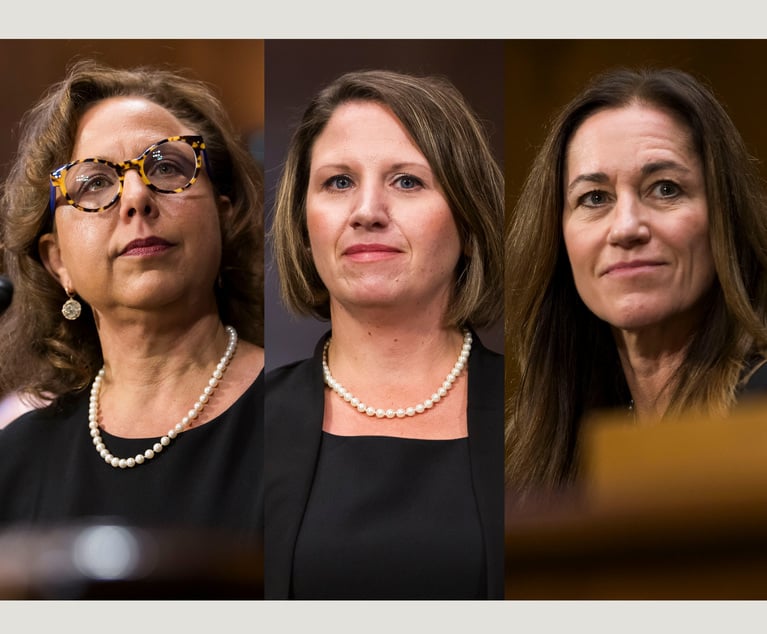Compensatory Education Can Help Realize Promise to English Language Learners
Equal educational opportunity, however, has proven elusive for ELLs—the EEOA's promise to them has not been realized. A significant achievement gap exists between ELLs and other students.
September 24, 2019 at 02:00 PM
5 minute read
 Kevin Golembiewski, Berney & Sang
Kevin Golembiewski, Berney & SangThe Equal Educational Opportunities Act (EEOA) promises equal educational opportunity to the over 4.5 million English language learners (ELLs) attending public schools. It requires states to "remove barriers to ELLs' equal participation in educational programs." If a state violates this command, and thus denies an ELL equal educational opportunity, the ELL can "institute a civil action in an appropriate district court … for such relief, as may be appropriate."
Equal educational opportunity, however, has proven elusive for ELLs—the EEOA's promise to them has not been realized. A significant achievement gap exists between ELLs and other students. ELLs consistently score below their peers on academic achievement tests, and high school dropout rates are higher for ELLs than other students in all 38 states that track ELL graduation rates.
Although the EEOA may never fully deliver on its promise to ELLs, it can be more effective than it has been to date. The EEOA gives courts broad discretion in crafting remedies for violations of ELLs' rights, and that discretion includes the ability to award compensatory education—a powerful tool for remedying a child's educational deficits that arise when a state violates a student's rights. Compensatory education includes prospective educational services such as tutoring, after-school classes and academic summer camps. But courts have yet to recognize compensatory education as a permissible form of EEOA relief.
That the EEOA allows compensatory education awards is confirmed by precedent awarding compensatory education under the Individuals with Disabilities Education Act (IDEA)—a civil rights statute that parallels the EEOA but protects only students with disabilities—and the EEOA's legislative history.
First, IDEA precedent awarding compensatory education establishes that the EEOA allows the awards because the relief available under the EEOA and the IDEA overlaps. The EEOA and the IDEA both protect educational rights; they both afford courts discretion to award any equitable relief that they deem "appropriate;" and they require courts to consider similar criteria when awarding relief to a student. Indeed, at least one court, the U.S. District Court for the District of Minnesota, has suggested that, given the EEOA's similarities to the IDEA, it permits compensatory education awards.
Second, Congress incorporated into the EEOA the broad equitable powers that courts exercised in school desegregation cases, including the power to award compensatory education. In 1974, the year Congress passed the EEOA, school desegregation efforts stemming from Brown v. Board of Education were ongoing, and courts, based on their broad equitable authority under the Fourteenth Amendment and Title VI of the Civil Rights Act, were regularly awarding compensatory education in desegregation cases. Against that backdrop, Congress enacted the EEOA, in part, to assist with school desegregation, and rather than cabining courts' authority to award compensatory education when school districts violate the statute, Congress embraced the broad equitable power that courts were exercising, conferring on them the discretion to award any relief that they deem appropriate.
Why, then, have courts still not recognized that compensatory education is a permissible form of relief under the EEOA? It appears that they simply have not had a meaningful opportunity to explore the role of compensatory education under the statute. EEOA claims are uncommon, and when they are raised, it is usually by groups of ELLs requesting comprehensive reforms to a school district's ELL programming. Claims seeking individualized relief, like compensatory education, are a legal novelty, so courts have not had many chances to consider requests for compensatory education.
Moving forward, advocates should make a concerted effort to establish compensatory education as a form of EEOA relief. Beyond serving as a powerful tool for remedying individual ELLs' educational deficits, compensatory education has the potential to bolster private enforcement of the EEOA and improve the statute's efficacy. Access to compensatory education awards would increase the benefits of individual EEOA claims, thereby fostering greater private enforcement. And with greater private enforcement, the EEOA would become a more effective anti-discrimination statute. School districts would be more likely to prioritize EEOA compliance since an EEOA violation would trigger a meaningful risk of litigation and the prospect of a costly compensatory education award.
Advocates can help establish compensatory education as a form of EEOA relief by requesting EEOA-based compensatory education in IDEA cases. When an ELL who has special needs seeks IDEA relief, if she and her parent have concerns about her ELL programming, their advocate should encourage them to raise a claim for EEOA-based compensatory education. Parents and students regularly pursue non-IDEA claims, such as claims under the Americans with Disabilities Act and Section 504 of the Rehabilitation Act of 1973, in IDEA cases. Adding EEOA claims to the mix is feasible and will present courts with more opportunities to examine whether the EEOA allows compensatory education awards.
Congress promised ELLs equal educational opportunity over 40 years ago, yet that promise is far from fulfilled. Compensatory education can help fix that.
Kevin Golembiewski is an associate with Berney & Sang. He focuses his practice on appeals, education law and employment law. Contact him at [email protected].
This content has been archived. It is available through our partners, LexisNexis® and Bloomberg Law.
To view this content, please continue to their sites.
Not a Lexis Subscriber?
Subscribe Now
Not a Bloomberg Law Subscriber?
Subscribe Now
NOT FOR REPRINT
© 2025 ALM Global, LLC, All Rights Reserved. Request academic re-use from www.copyright.com. All other uses, submit a request to [email protected]. For more information visit Asset & Logo Licensing.
You Might Like
View All
Pa. Federal District Courts Reach Full Complement Following Latest Confirmation

The Defense Bar Is Feeling the Strain: Busy Med Mal Trial Schedules Might Be Phila.'s 'New Normal'
7 minute read
Federal Judge Allows Elderly Woman's Consumer Protection Suit to Proceed Against Citizens Bank
5 minute read
Judge Leaves Statute of Limitations Question in Injury Crash Suit for a Jury
4 minute readTrending Stories
- 1LexisNexis Announces Public Availability of Personalized AI Assistant Protégé
- 2Some Thoughts on What It Takes to Connect With Millennial Jurors
- 3Artificial Wisdom or Automated Folly? Practical Considerations for Arbitration Practitioners to Address the AI Conundrum
- 4The New Global M&A Kings All Have Something in Common
- 5Big Law Aims to Make DEI Less Divisive in Trump's Second Term
Who Got The Work
J. Brugh Lower of Gibbons has entered an appearance for industrial equipment supplier Devco Corporation in a pending trademark infringement lawsuit. The suit, accusing the defendant of selling knock-off Graco products, was filed Dec. 18 in New Jersey District Court by Rivkin Radler on behalf of Graco Inc. and Graco Minnesota. The case, assigned to U.S. District Judge Zahid N. Quraishi, is 3:24-cv-11294, Graco Inc. et al v. Devco Corporation.
Who Got The Work
Rebecca Maller-Stein and Kent A. Yalowitz of Arnold & Porter Kaye Scholer have entered their appearances for Hanaco Venture Capital and its executives, Lior Prosor and David Frankel, in a pending securities lawsuit. The action, filed on Dec. 24 in New York Southern District Court by Zell, Aron & Co. on behalf of Goldeneye Advisors, accuses the defendants of negligently and fraudulently managing the plaintiff's $1 million investment. The case, assigned to U.S. District Judge Vernon S. Broderick, is 1:24-cv-09918, Goldeneye Advisors, LLC v. Hanaco Venture Capital, Ltd. et al.
Who Got The Work
Attorneys from A&O Shearman has stepped in as defense counsel for Toronto-Dominion Bank and other defendants in a pending securities class action. The suit, filed Dec. 11 in New York Southern District Court by Bleichmar Fonti & Auld, accuses the defendants of concealing the bank's 'pervasive' deficiencies in regards to its compliance with the Bank Secrecy Act and the quality of its anti-money laundering controls. The case, assigned to U.S. District Judge Arun Subramanian, is 1:24-cv-09445, Gonzalez v. The Toronto-Dominion Bank et al.
Who Got The Work
Crown Castle International, a Pennsylvania company providing shared communications infrastructure, has turned to Luke D. Wolf of Gordon Rees Scully Mansukhani to fend off a pending breach-of-contract lawsuit. The court action, filed Nov. 25 in Michigan Eastern District Court by Hooper Hathaway PC on behalf of The Town Residences LLC, accuses Crown Castle of failing to transfer approximately $30,000 in utility payments from T-Mobile in breach of a roof-top lease and assignment agreement. The case, assigned to U.S. District Judge Susan K. Declercq, is 2:24-cv-13131, The Town Residences LLC v. T-Mobile US, Inc. et al.
Who Got The Work
Wilfred P. Coronato and Daniel M. Schwartz of McCarter & English have stepped in as defense counsel to Electrolux Home Products Inc. in a pending product liability lawsuit. The court action, filed Nov. 26 in New York Eastern District Court by Poulos Lopiccolo PC and Nagel Rice LLP on behalf of David Stern, alleges that the defendant's refrigerators’ drawers and shelving repeatedly break and fall apart within months after purchase. The case, assigned to U.S. District Judge Joan M. Azrack, is 2:24-cv-08204, Stern v. Electrolux Home Products, Inc.
Featured Firms
Law Offices of Gary Martin Hays & Associates, P.C.
(470) 294-1674
Law Offices of Mark E. Salomone
(857) 444-6468
Smith & Hassler
(713) 739-1250





